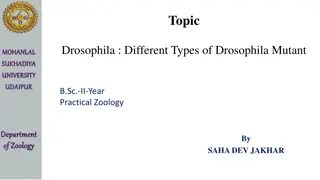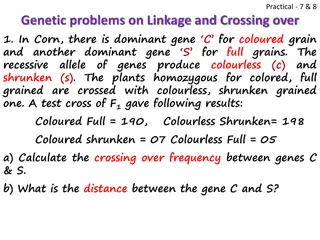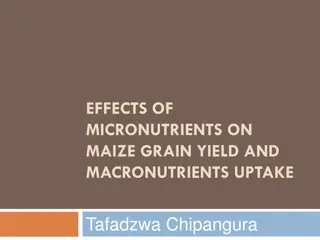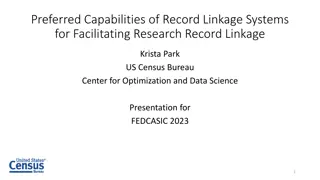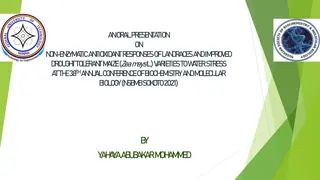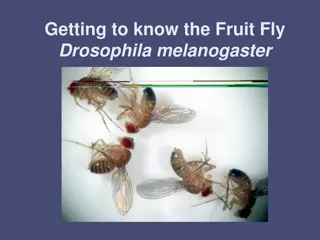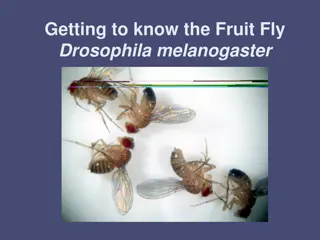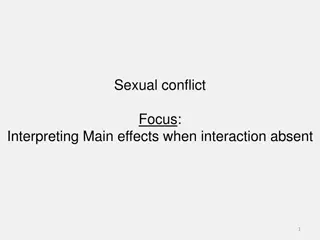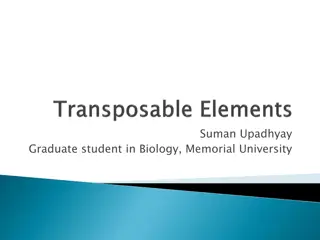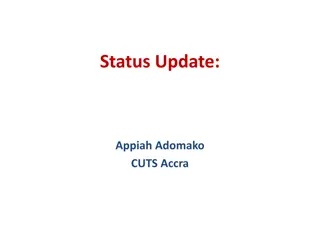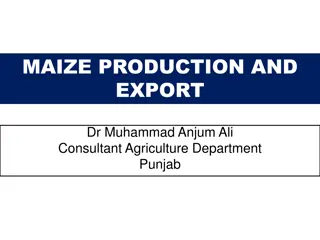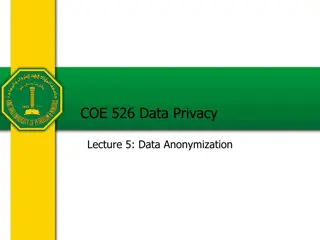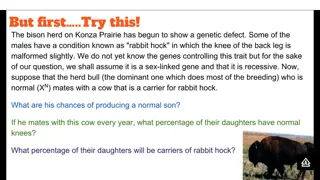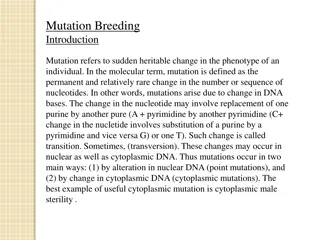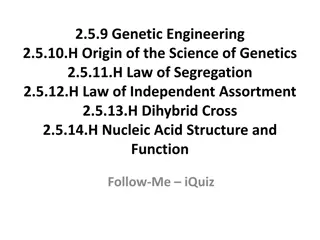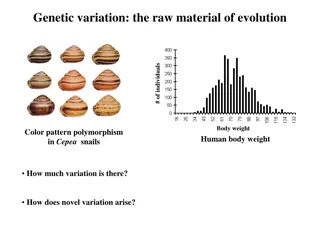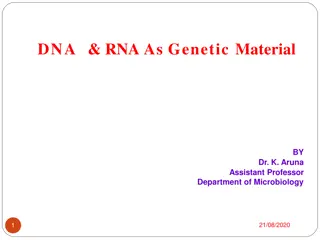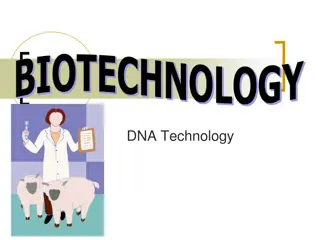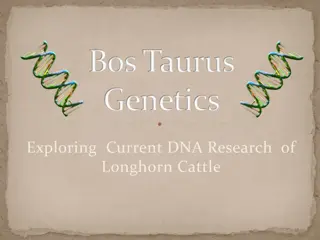Understanding Genetic Linkage in Maize and Drosophila
The concept of genetic linkage is explored through experiments in maize and Drosophila, showcasing how specific traits are inherited together due to their close association on chromosomes. In maize, the phenomenon of linkage is demonstrated through color and endosperm traits, while in Drosophila, complete and incomplete linkage is illustrated with body color and wing size variations. The role of crossing over in determining the extent of linkage is also discussed, highlighting the intricate interplay of genes during inheritance.
Download Presentation

Please find below an Image/Link to download the presentation.
The content on the website is provided AS IS for your information and personal use only. It may not be sold, licensed, or shared on other websites without obtaining consent from the author. Download presentation by click this link. If you encounter any issues during the download, it is possible that the publisher has removed the file from their server.
E N D
Presentation Transcript
Dr.I.Viji Margaret Assistant Professor, PG Dept.of Zoology, Sarah Tucker College, Tirunelveli
Linkage in Maize The phenomenon of linkage is very clear in maize, varieties He crossed varieties with colored and full with verities with colorless shrunken seeds. coloured and full are dominate over colourless and shrunken. All the f1plants were coloured full. When F1 hybrid plants were test crossed with p1 double recessives the result was not 1:1:1:1 ratios as excepted, instead the parental combinations constituted about 96.4% of the total plants. the recombination new plants constituded only 3.6% of the total plants. The parental combinations of coloured full and colourless shrunken constituted 96.4% .of the total offspring of F2 due to linkage of genes for these characters. The genes for colour and endosperm nature remain associated in parental combinations in 96.4 % of gametes but break apart in 3.6% of the total F2 plants. Morgan explained the recombinations of linked genes due to interchange of parts between nonsister chromatids of homologous which he called crossing over.
Linkage in Drosophila There are types of linkage in drosophila A) Complete linkage in male drosophila. B) Incomplete linkage in female drosophila. The linked genes are inherited together through two or more generation without crossing- over in male Drosophila. In drosophila gray body and long wings (GG) and long wings (LL) are dominant over black body (GG) and vestigial wings (ll) when a male fly with grey body and long wings is mated with a female fly with black body and vestigial wings, all the resulting F1 flies are with gray body and long wings. Nevertheless in a test cross between F1 hybrid male and P1 double recessive female, the F2 generation consists of 50% individuals with gray body and long wings and another 50% individuals with block body and vestigial wings. Thus we see that the genes for gray body and long wings are linked; similarly the genes for block body and vestigial wings are also linked.
B) Incomplete linkage in female drosophila. Here the linked genes do not always stay together because of crossing-over between nonsister chromatids of homologous chromosomes. The linked genes are likely to be separated due to crossing over and in such cases the linkage is termed incomplete.g., female drosophila. If the female F1 hybrid drosophila of the previous cross is test crossed to p1 double recessive male then in the F2 generation, two new combinations do appear, in addition to the parental combinations. The new combinations are gray vestigial and block long. These appear in equal numbers and constitute 17% of F2. The parental combinations account for 83% of F2 and are due to linkage.
THERIES OF LINKAGE Two theories are given below; 1. Theory of differential multiplication. This theory was formulated by Bateson (1930). According to this theory, after segregation of characters during gamete formation, the set of gametes possessing parental combinations. This result in greater number of gametes with parental combinations and hence greater number of offspring with parental combinations. This theory is now obsolete. 2. Chromosome theory of linkage. This theory was advocated by Morgan and castle. This theory states that genes located in the same chromosomes are inherited together and the extent of linkage is indeed correlated with the distance between the genes in the chromosomes-closer the genes, stronger the linkage and vice-versa. The linkage of genes according to the concept is linear.
Crossing-over Complete linkage is rare, because frequently during meiosis, there occurs break age and interchange of parts between nonsister chromatids of alleles between nonsister chromatids of homologous chromosomes, during Pachytene of meiosis , resulting in recombination of genes.One or two or more fragments may be intercganged during crossing over For example,
When the female drosophila with gray body ad long wings (GLgl) is crossed in a male, homozygous, with black body and vestigial wings (glgl) four types of flies are formed. These are given below: 1.Gray long (41.5%) 2.Block vestigial (41.5)% 3.Gray vestigial (8.5)% }17% 4.Block long (8.5)% The last two combinatios viz. gray vestigial and black long appear in equal numbers and constitute 17% of the total offspring. There two new combinations are formed as a result of a result of crossing over between homologous chromosomes, during gamete formation in female drosophila. Recombination thus takes place in 17% of the gametes as a result of crossing over, resulting in two new combinations, which substantiate genetic crossing over.
Theories of mechanism of crossing over Three theories are given below: 1.The contact first theory. This theory was formulated by serebrovsky. According to this theory the chromatids first touch and cross each other and then breakage takes place. The broken ends rejoin to form new combinations. Thus according to this concept, chiasma is formed first and crossing over takes place subsequently. 2.The breakage first theory. This theory was put forward by muller. According to this theory, the chromatids break off frist, and then crossing-over takes place between nonsister chromatids. The chiasma is formed due to crossing-over. In other words, it is the result of crossing over. 3. The strain theory. This theory was advocated by darlington. The chromatids do break off at the points of contact, relieving the chromatids of the strain. Later the broken chromatids uncoil near the broken end, and reunite to from chiasma, resulting in new combinations.
Kinds of crossing-over Depending upon the number of chiasmata formed, the following type of crossing- over are recognized: Single crossing-over. Here only one cchiasma are formed and this results in the formation of single cross- over gametes. Double crossing-over. Here two chiasmata are formed. Both the crossing over can be between the same nonsister chromatids or between different chromatids. Two or three or all the four chromatids of the bivalents may be involved in this double crossing-over. Multiple crossing-over. Here more than two chiasmata are formed as a result of crossing over.



